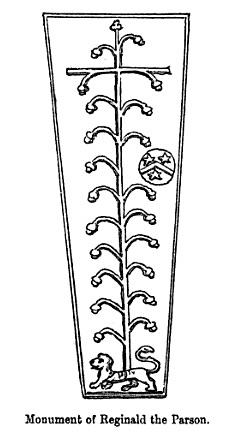| Notes |
- From The Chetwynds of Ingestre, citation details below:
Reginald de Chetwynd, the son of the first wife, was an acolyte when he was presented to the rectory of Chetwynd, but if I have rightly interpreted the Plea Roll quoted above, he must have been born prior to 1292, and at least six-and-twenty when he was inducted and allowed a year's dispensation to study. An acolyte in the Roman Catholic Church is not necessarily a boy. The term was applied to any young person whose mind was set upon Holy Orders. The practice of conferring livings on youths of even tender age, and allowing them to retire for study afterwards, was not uncommon in Langton's episcopate. We have seen how the elder Reginald surrendered his estate to his cousin in 1318. Five and twenty years later (1344) another fine was enrolled at Westminster between Sir John and his son the parson of Chetwynd. By the first settlement the younger Reginald would become next heir at his father's death, but as a priest he could neither hold land himself nor could his daughter, being held to be illegitimate, though at this time many of the English clergy were married and living with their families in their parsonages, just as their successors do now. A common legal fiction must therefore be devised to ensure the inheritance to his daughter. Accordingly, a suitable match having been first provided for the young lady, and Sir John having recognised his son's right under the former settlement, Reginald granted his estate back to his father for life, with remainder afterwards to Richard, son of Adam de Peshale, and his wife Joan. Thus the priest's daughter is ingeniously kept out of sight, and Sir John's estate, passing direct to Peshale at his death, was saved from the Church, "that great gulf," as Blackstone says, "in which all the property in the kingdom was in danger of being swallowed up." Once more we hear of Reginald when he exchanged livings with John de Downton of Kynnersley in 1351, but he returned to Chetwynd at his death. Captain Symonds describes the monument he saw in 1645--"In the middle of the chancel a flat stone, an ancient cross with floreated staff resting on a lion. On the right side of the cross a circular shield bearing the coat of Chetwynd."

Gough also saw it in 1790, and describes it as "that of a priest entitled to bear arms." The church which Gough saw was a plain brick structure adjoining the house, pulled down a few years ago.
|
 Nielsen Hayden genealogy
Nielsen Hayden genealogy [2, 3]
[2, 3]  [2]
[2]  d. Aft 1354 (Age ~ 92 years)
d. Aft 1354 (Age ~ 92 years)  d. Aft 1343
d. Aft 1343